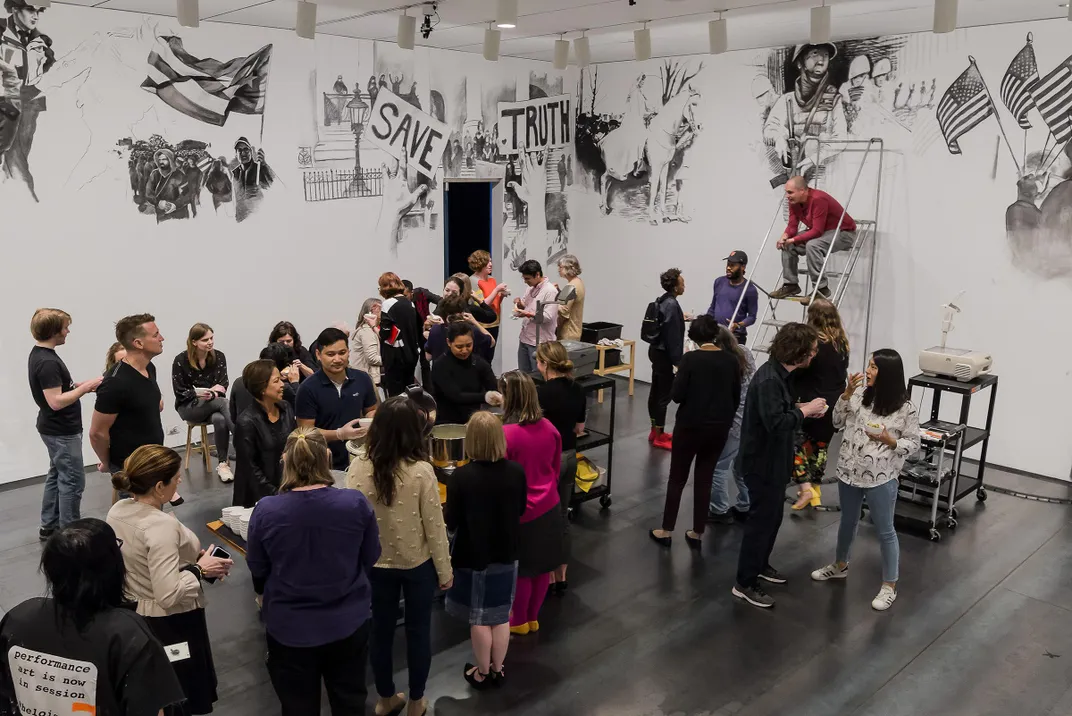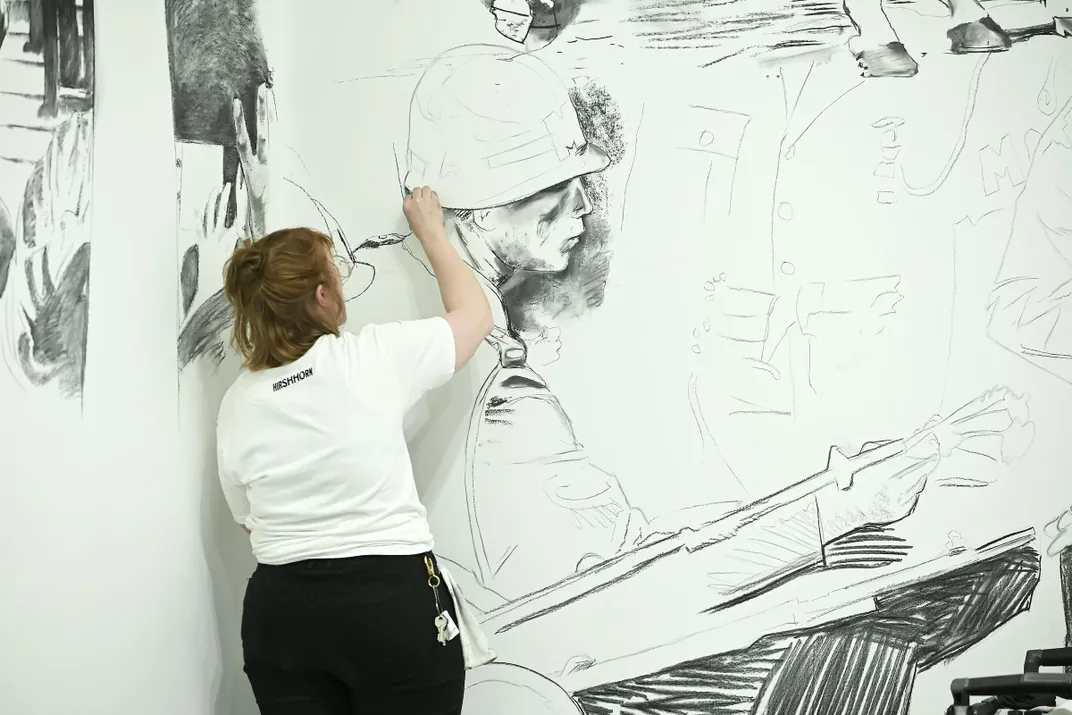This Performance Art Piece Is Being Served Up With Tasty, Warm Bowls of Curry
Amid evolving images of protest and strife, Rirkrit Tiravanija’s art at the Hirshhorn satisfies both visually and nutritionally
/https://tf-cmsv2-smithsonianmag-media.s3.amazonaws.com/filer/be/70/be70a8ca-c661-488c-ae91-fc55ef237b32/2019rirkritmay16-243-1.jpg)
The graphite images on the stark white gallery walls show images of pain and protest, death and marching. Some of the scenes are familiar, historic and even iconic images from Martin Luther King Jr’s 1963 March on Washington to the Million Man March; the suffragists to the Women’s March; all alongside grislier scenes of Taiwanese uprisings.
In the middle of the room, almost antithetic to the strife, are nurturing bowls of curry, given to each viewer in the museum who wants one, allowing visitors to eat, consider and perhaps to talk with one another about the swirl of events so vividly displayed around them.
If Rirkrit Tiravanija’s new piece at the Hirshhorn Museum and Sculpture Garden is actually performance art, some of the performers must be the visitors who consume the tasty Thai cuisine, as well as the local muralists who continue to toil on the wall images, using overhead projectors, scaffolding and charcoal.
Tiravanija has used shared food in his work for three decades. The Argentine-born, Canadian-trained artist has provided communal meals in work dating to Untitled Empty Parenthesis in 1989, and Untitled (Free) in 1992. His 1999 piece Untitled went a bit further, inviting people to live in a gallery replica of his East Village artist.
For his (who’s afraid of red, yellow and green), first exhibited in Bangkok in 2010 and acquired by the Hirshhorn in 2017, Tiravanija has a popular local restaurant, Beau Thai, to prepare and present three curries—red, yellow and green.

The colors refer to political groups at odds in contemporary Thailand—the red for the rural activists, the yellow for the royalists and the green for the ever-pervasive military. But the title also is a reference to a series of paintings that the American abstract expressionist painter Barnett Newman completed from 1966 to 1970, Who’s Afraid of Red, Yellow and Blue, a couple of which were defaced by those claiming it perverted the colors of the German flag.
But apart from all those references, Tiravanija says, the three colors represent the three basic curries, nourishing food for the belly while contemplating the images’ food for thought.
Food is served during lunchtime Thursdays through Sundays through July 24 to the first 150 or so comers, or until supplies are exhausted. Including warm food as part of an exhibition presented a new set of challenges for the museum, director Melissa Chiu says. There was no way they could allow the open flame used in previous stagings of the piece, for example.
But she says she’s “excited to introduce Tiravanija’s interactive culinary experience to the Washington, D.C. community” with a piece that “offers new perspectives on the ways in which art and creativity are used to interpret political and social issues of our time.”
/https://tf-cmsv2-smithsonianmag-media.s3.amazonaws.com/filer/1a/eb/1aeb7bf8-2ae4-4278-bec1-05d1e75a6db7/img_2077.jpg)
It’s not often that galleries gather ephemeral works involving food, community and drawings, she says.
As the wall text indicates, viewers “are invited to look, smell and taste as the artist asks us to consider the unpalatable facts of history alongside the communal, domestic and universal act of sharing food.”
Wearing a John Deere cap and mingling among the food lines and artists’ scaffolds soon after the opening, Tiravanija, 57, says that when he first created (who’s afraid of red, yellow and green) in Bangkok, “society felt very fractured—even between artists.”
He had been collecting newspaper images of protests that seemed to have exploded worldwide since the War in Iraq began. He paid special attention to the uprisings in Thailand this century that drew a brutal response.
/https://tf-cmsv2-smithsonianmag-media.s3.amazonaws.com/filer/d7/7b/d77b2d7a-8ac2-4ab1-a4ff-962434edd087/2019rirkritmay16-458.jpg)
He gives free reign to locally hired artists in drawing the wall images. While students were enlisted other places, though, some of the city’s most esteemed muralists were engaged to draw much more sure-handed political images—a process that will continue as long as the work is on display.
“The idea is to draw over other images and layer it until the wall will become completely black,” Tiravanija says. “It will become more layered and complex, but eventually everything will be so covered, people will forget.”
And in a setting where people enjoy the same food, perhaps they can eventually share similar ideas, he says.
It certainly gives a new meaning to consuming art. Rarely has an exhibition been so literally nourishing.

The installation includes a couple of rooms of documentary films (where food, as in the rest of the museum, is not allowed). One, directed by Tiravanija, is a long, languid look at rural life in Thailand, Lung Neaw Visits His Neighbors. A second room has a series of documentary shorts from 2004 to 2017 curated for the museum by Thai independent filmmaker Apichatpong Weerasethakul, who’s film Uncle Boonmee Who Can Recall His Past Lives won the 2010 Cannes Film Festival Palme d’Or.
The short films, made from 2004 to 2017, reflect the social and political scene in contemporary Thailand. One concerns a mother’s laments after losing a son in a protest. Another collects images from Thai soap operas; another shows young men exchanging ideas, a third shows how the city comes to a halt as the national anthem is played nightly.
The museum held a special screening June 8 of a U.S. film chosen by Tiravanija, the 1963 The Ugly American, starring Marlon Brando as an ambassador who travels to a Southeast Asian country where he views conflicts as communism vs. democracy, but fails to detect the underlying complexity.
“It’s a film I saw as a child, showing how politics can be manipulated,” Tiravanija says.
Of the multi-media approach, though, it is the four-day lunch line that is something new for the Hirshhorn, says Mark Beasley, the museum’s curator of media and performance art. But it’s also relatively new practice to acquire a performance piece at all. When the piece closes on July 24, the walls will be whitewashed again for the next exhibition. And the written plans for the piece will be neatly filed away until it is staged again.
“Rirkrit Tiravanija: (who’s afraid of red, yellow and green)” continues through July 24 at the Smithsonian’s Hirshhorn Museum and Sculpture Garden in Washington, D.C. Food is served from 11:30 a.m. to about 1:30 p.m. Thursday through Sundays, or until supplies run out.
/https://tf-cmsv2-smithsonianmag-media.s3.amazonaws.com/accounts/headshot/RogerCatlin_thumbnail.png)
/https://tf-cmsv2-smithsonianmag-media.s3.amazonaws.com/accounts/headshot/RogerCatlin_thumbnail.png)